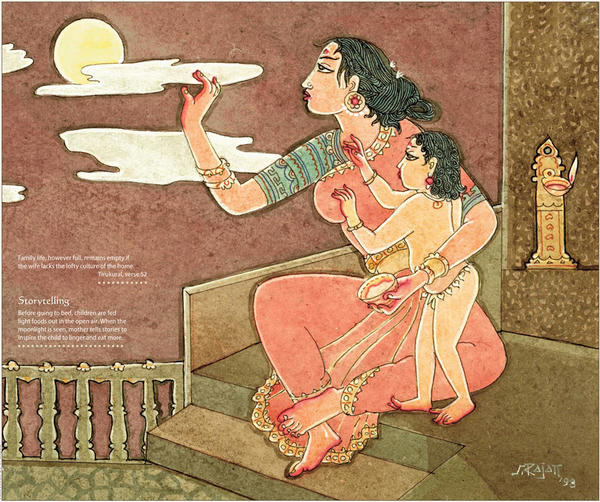
C H A P T E R 4 0§
Honoring The Arts of Homemaking

_______________
An Artist’s Portrayal of the Hindu Wife’s Traditional Domestic Duties§
_______________
 ODAY, COMMUNITIES AND PEOPLES ALL OVER THE WORLD ARE REEVALUATING how we live. As a global community, we are seeking more sustainable ways of life, seeking solutions to the myriad problems that our modern ways have caused since the Industrial Revolution—global warming, polution of our air and waterways, concretization of our lands, deforestation, and the social ills of crime, poverty, abuse and broken homes. Peoples are evaluating old, traditional system to learn or relearn how we got along in the old days, without so many conveniences, when life was simpler, less competetive, less stressful and frantic. In this chapter, we bring you a collection of painting by S. Rajam, a gifted artist and musician born in a South Indian village in the old days of 1918, that depict the daily rituals commonly performed by Hindu wives and homemakers all over India, during his time and for centuries before. The same rituals can still be found today in villages and urban centers. The scenes in his 14 pieces follows the sequence of a day, from morning to dusk. §
ODAY, COMMUNITIES AND PEOPLES ALL OVER THE WORLD ARE REEVALUATING how we live. As a global community, we are seeking more sustainable ways of life, seeking solutions to the myriad problems that our modern ways have caused since the Industrial Revolution—global warming, polution of our air and waterways, concretization of our lands, deforestation, and the social ills of crime, poverty, abuse and broken homes. Peoples are evaluating old, traditional system to learn or relearn how we got along in the old days, without so many conveniences, when life was simpler, less competetive, less stressful and frantic. In this chapter, we bring you a collection of painting by S. Rajam, a gifted artist and musician born in a South Indian village in the old days of 1918, that depict the daily rituals commonly performed by Hindu wives and homemakers all over India, during his time and for centuries before. The same rituals can still be found today in villages and urban centers. The scenes in his 14 pieces follows the sequence of a day, from morning to dusk. §
Then, as now, the wife and mother carries a momentus responsibility—the creation of a stable home and the raising of a fully functioning family. Her role, apart from the competitive, breadwinner world of men, is every bit as essential as her husband’s. Rightly performed, each part of her daily ritual is done with a mindfulness based on knowledge of the workings of subtle energies, and of unseen angelic beings—the guardian devas of family members—and the aid they give. For example: the home’s doorways and windows are seen as portals through which either helpful or antagonistic beings can enter. So daily decorating of entryways entreats guardian devas to allow access only to those who will strengthen and support the family. Similarly, she knows the womanly energy she embues into a meal during its preparation can increase the health of all who partake of it, or, if negative, contribute to illness and distress. She also understands that clothing and other possessions respond to care or neglect just as people do, and that cleanliness and love bring forth a refined spiritual vibration. All her efforts serve to make the home a holy place. Indeed, each of the duties depicted in Rajam’s art has esoteric and mystical aspects to be discovered and developed by the intuitive woman.§
To urban wives and those living abroad, some of the tasks may seem irrelevant and the methods outdated, even demeaning. Rajam hopes modern Hindu individuals will discover how each duty relates to the current household environment. This woman’s rustic tools may be replaced with electric utensils and food processors. Even the modern refrigerator door can be transformed into a place of blessing by daily posting a freshly ink-jetted kolam design upon it. With applied intuition and ingenuity, similar modernization of each of these principles will move them meaningfully into the future. And some of the simplicity may be revived in our efforts to find sustainable ways to survive on into the future.§